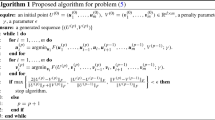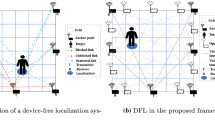Abstract
Recently Wang, Zheng, Boyd, and Ye (SIAM J Optim 19:655–673, 2008) proposed a further relaxation of the semidefinite programming (SDP) relaxation of the sensor network localization problem, named edge-based SDP (ESDP). In simulation, the ESDP is solved much faster by interior-point method than SDP relaxation, and the solutions found are comparable or better in approximation accuracy. We study some key properties of the ESDP relaxation, showing that, when distances are exact, zero individual trace is not only sufficient, but also necessary for a sensor to be correctly positioned by an interior solution. We also show via an example that, when distances are inexact, zero individual trace is insufficient for a sensor to be accurately positioned by an interior solution. We then propose a noise-aware robust version of ESDP relaxation for which small individual trace is necessary and sufficient for a sensor to be accurately positioned by a certain analytic center solution, assuming the noise level is sufficiently small. For this analytic center solution, the position error for each sensor is shown to be in the order of the square root of its trace. Lastly, we propose a log-barrier penalty coordinate gradient descent method to find such an analytic center solution. In simulation, this method is much faster than interior-point method for solving ESDP, and the solutions found are comparable in approximation accuracy. Moreover, the method can distribute its computation over the sensors via local communication, making it practical for positioning and tracking in real time.
Similar content being viewed by others
References
Alfakih A.Y.: Graph rigidity via Euclidean distance matrices. Linear Algebra Appl. 310, 149–165 (2000)
Aspnes, J., Goldenberg, D., Yang, Y.R.: On the computational complexity of sensor network localization, in ALGOSENSORS 2004, Turku, Finland, Lecture Notes in Computer Science, vol. 3121, pp. 32–44. Springer, New York (2004)
Biswas, P., Semidefinite programming approaches to distance geometry problems, Ph. D. Thesis, Department of Electrical Engineering, Stanford University, Stanford. http://pratik.biswas.googlepages.com (2007)
Biswas, P., Aghajan, H., Ye, Y.: Semidefinite programming algorithms for sensor network localization using angle of arrival information. In: Proceedings of the 39th Annual Asilomar Conference on Signals, Systems, and Computers, Pacific Grove, CA (2005)
Biswas P., Liang T.-C., Toh K.-C., Wang T.-C., Ye Y.: Semidefinite programming approaches for sensor network localization with noisy distance measurements. IEEE Trans. Auto. Sci. Eng. 3, 360–371 (2006)
Biswas P., Liang T.-C., Wang T.-C., Ye Y.: Semidefinite programming based algorithms for sensor network localization. ACM Trans. Sensor Networks 2, 188–220 (2006)
Biswas P., Toh K.-C., Ye Y.: A distributed SDP approach for large-scale noisy anchor-free graph realization with applications to molecular conformation. SIAM J. Sci. Comput. 30, 1251–1277 (2008)
Biswas, P., Ye, Y.: Semidefinite programming for ad hoc wireless sensor network localization. In: Proceedings of the 3rd IPSN, Berkeley, CA, pp. 46–54 (2004)
Biswas, P., Ye, Y.: A distributed method for solving semidefinite programs arising from ad hoc wireless sensor network localization. In: Mutiscale Optimization Methods and Applications, Nonconvex Optimization and Applications, vol. 82, pp. 69–84. Springer, New York (2006)
Carter W., Jin H.H., Saunders M.A., Ye Y.: SpaseLoc: an adaptive subproblem algorithm for scalable wireless sensor network localization. SIAM J. Optim. 17, 1102–1128 (2006)
Ding, Y., Krislock, N., Qian, J., Wolkowicz, H.: Sensor network localization, Euclidean distance matrix completions, and graph realization. Report, Department of Combinatorics and Optimization, University of Waterloo, Waterloo, February 2008
Doherty, L., Pister, K.S.J., El Ghaoui, L.: Convex position estimation in wireless sensor networks. In: Proceedings of the 20th INFOCOM, vol. 3, pp. 1655–1663. Los Alamitos, CA (2001)
Eren, T., Goldenberg, D.K., Whiteley, W., Yang, Y.R., Morse, A.S., Anderson, B.D.O., Belhumeur, P.N.: Rigidity: computation, and randomization in network localization. In: Proceedings of the 23rd INFOCOM, vol. 4, pp. 2673– 2684. Los Alamitos, CA (2004)
Fariña, N., Miguez, J., Bugallo, M.F.: Novel decision-fusion algorithms for target tracking using ad hoc networks. In: Proceedings of the 61st Vehicular Technology Conference, vol. 4, pp. 2556–2559 (2005)
Gustafsson F., Gunnarsson F., Bergman N., Forssell U., Jansson J., Karlsson R., Nordlund P.: Particle filters for positioning, navigation, and tracking. IEEE Trans. Signal Proc. 50, 425–437 (2002)
Hightower J., Borriello G.: Location systems for ubiquitous computing. Computer 34, 57–66 (2001)
Horn R.A., Johnson C.R.: Matrix Analysis. 2nd edn. Cambridge University Press, New York (2005)
Kim S., Kojima M., Waki H.: Exploiting sparsity in SDP relaxation for sensor network localization. SIAM J. Optim. 1, 192–215 (2009)
Krislock, N., Piccialli, V., Wolkowicz, H.: Robust semidefinite programming approaches for sensor network localization with anchors. Report, Department of Combinatorics and Optimization, University of Waterloo, Waterloo, May 2006
Liang, T.-C., Wang, T.-C., Ye, Y.: A gradient search method to round the semidefinite programming relaxation solution for ad hoc wireless sensor network localization. Report, Electrical Engineering, Stanford University, Stanford. http://serv1.ist.psu.edu:8080/viewdoc/summary?doi=10.1.1.81.7689 (2004)
Liu, J., Zhang, Y., Zhao, F.: Robust distributed node localization with error management. In: Proceedings of the 7th ACM International Symposium on Mobile Ad Hoc Networking and Computing, Florence, Italy, pp. 250–261 (2006)
Moré J.J., Wu Z.: Global continuation for distance geometry problems. SIAM J. Optim. 7, 814–836 (1997)
Nasipuri, A., Li, K.: A directionality based location discovery scheme for wireless sensor networks. In: Proceedings of the 1st ACM International Workshop on Wireless Sensor Networks and Applications, Atlanta, GA, pp. 105–111 (2002)
Neto J.X., Ferreira O.P., Monteiro R.D.C.: Asymptotic behavior of the central path for a special class of degenerate SDP problems. Math. Program. 103, 487–514 (2005)
Niculescu D., Nath B.: Ad hoc positioning system (APS) using AOA. IEEE INFOCOM 3, 1734–1743 (2003)
Nie J.: Sum of squares method for sensor network localization. Comput. Optim. Appl. 43, 151–179 (2009)
Rao, A., Ratnasamy, S., Papadimitriou, C., Shenker, S., Stoica, I.: Geographic routing without location information. In: Proceedings of the 9th Annual International Conference on Mobile Computing and Networking (MobiCom ’03), San Diego, CA, pp. 96–108 (2003)
Savarese, C., Rabaey, J. M., Langendoen, K.: Robust positioning algorithms for distributed ad-hoc wireless sensor networks. In: Proceedings USENIX Annual Technical Conference, Monterey, CA, pp. 317–327 (2002)
Saxe, J.B.: Embeddability of weighted graphs in k-space is strongly NP-hard. In: Proceedings of the 17th Allerton Conference in Communications, Control, and Computing, Monticello, IL, pp. 480–489 (1979)
Shang Y., Ruml W., Zhang Y., Fromherz M.: Localization from connectivity in sensor networks. IEEE Trans. Parallel Distrib. Syst. 15, 961–974 (2004)
Simić, S.N., Sastry, S.: Distributed localization in wireless ad hoc networks. Report, Department of Electrical Engineering and Computer Sciences, University of California, Berkeley, 2002; First ACM International Workshop on Wireless Sensor Networks and Applications, Atlanta, GA (2002) submitted
So A.M.-C., Ye Y.: Theory of semidefinite programming for sensor network localization. Math. Program. 109, 367–384 (2007)
Sturm, J.F.: Using SeDuMi 1.02, A Matlab* toolbox for optimization over symmetric cones (updated for Version 1.05), Report, Department of Econometrics, Tilburg University, Tilburg, Aug–Oct (1998–2001)
Tseng P.: Second-order cone programming relaxation of sensor network localizations. SIAM J. Optim. 18, 156–185 (2007)
Tseng P., Yun S.: A coordinate gradient descent method for nonsmooth separable minimization. Math. Program. 117, 387–423 (2009)
Wang Z., Zheng S., Ye Y., Boyd S.: Further relaxations of the semidefinite programming approach to sensor network localization. SIAM J. Optim. 19, 655–673 (2008)
Wei, Z.: Large scale sensor network localization, Report, Department of Statistics, Stanford University, Stanford, November 2006
Zhang, Y.: Private commuication, January 2009
Author information
Authors and Affiliations
Corresponding author
Additional information
This work is supported by National Science Foundation grant DMS-0511283.
Rights and permissions
About this article
Cite this article
Pong, T.K., Tseng, P. (Robust) Edge-based semidefinite programming relaxation of sensor network localization. Math. Program. 130, 321–358 (2011). https://doi.org/10.1007/s10107-009-0338-x
Received:
Accepted:
Published:
Issue Date:
DOI: https://doi.org/10.1007/s10107-009-0338-x
Keywords
- Sensor network localization
- Semidefinite programming relaxation
- Error bound
- Log-barrier
- Coordinate gradient descent




